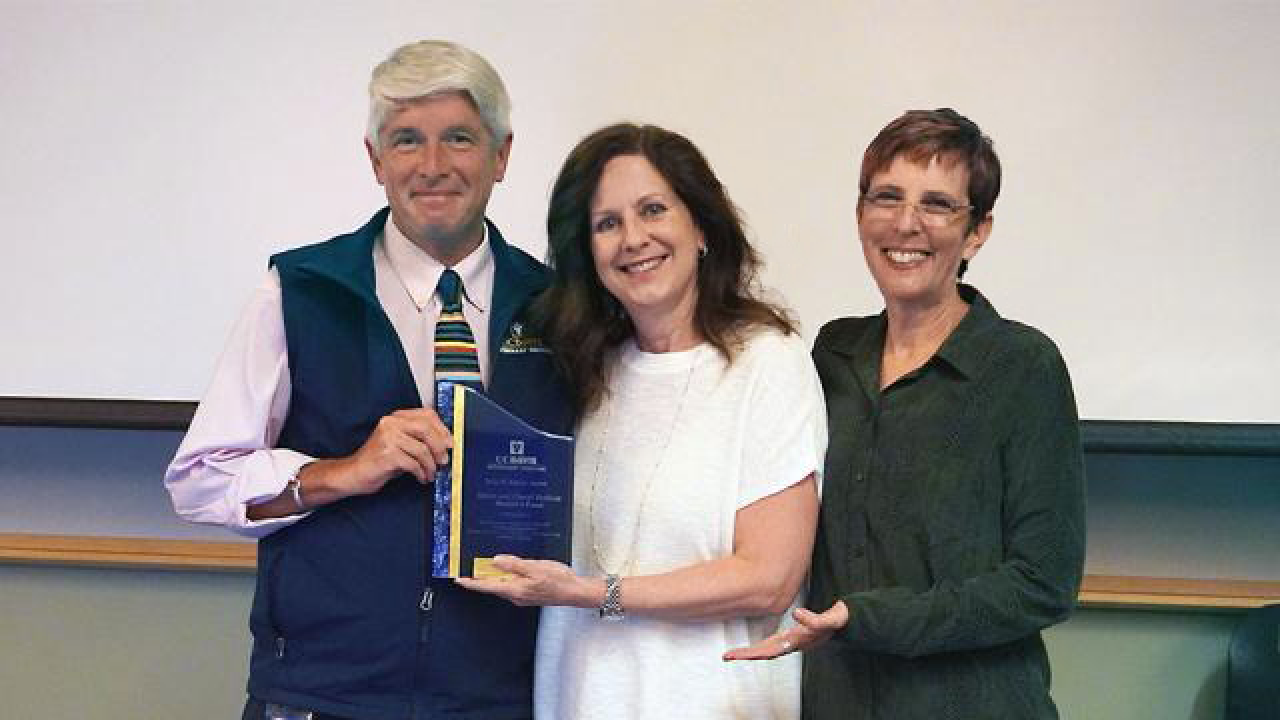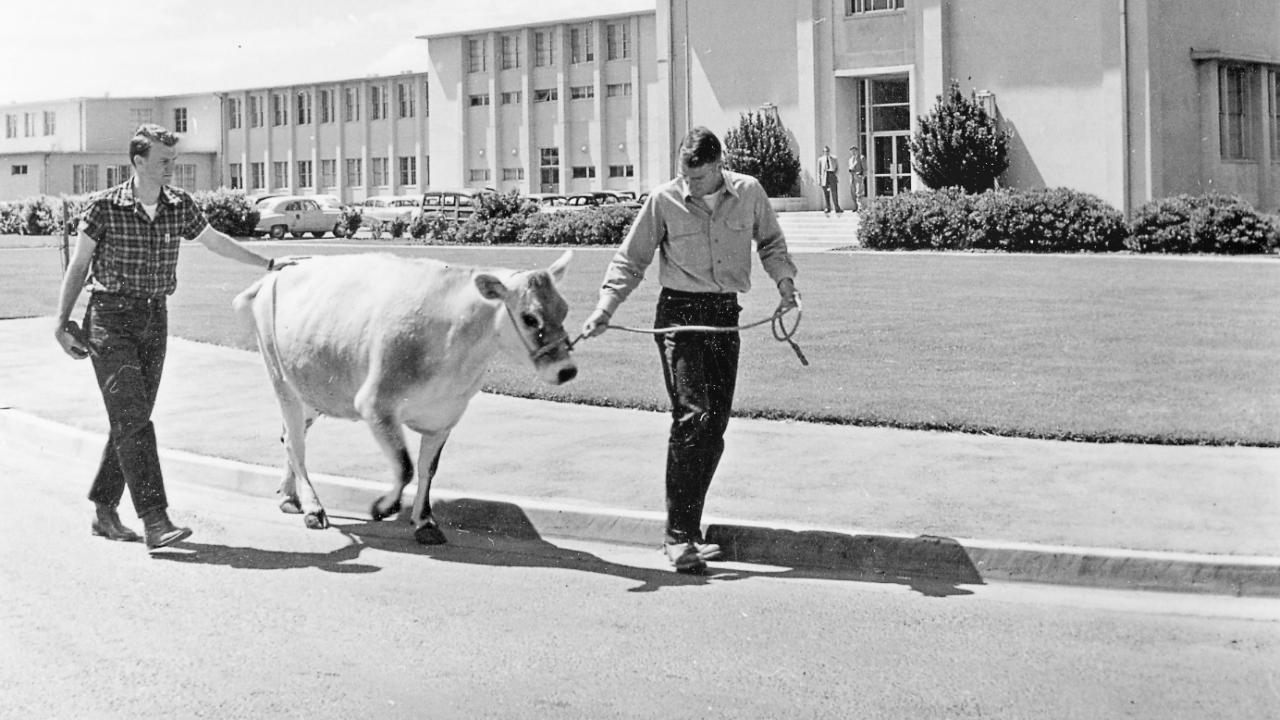UC Davis Veterinary Medicine is a school and medical center of distinction
Ranked #1 in the nation by U.S. News & World Report (2025)
Ranked #2 in the world by QS World University Rankings (2025)
Higher Education Excellence in Diversity Award (2025)
The School of Veterinary Medicine has shaped the field of veterinary medicine, developing dynamic veterinary treatments and making key discoveries related to animal, human and environmental health. Experts in dozens of scientific disciplines train future veterinarians and mentor leaders in veterinary practice, higher education, public health/food safety, research, environmental protection, and biotechnology. Dean Mark Stetter stepped into his leadership role in October of 2021.
One Health
The school is renowned for applying a “One Health” approach to addressing critical health concerns on a local and global scale to improve the lives of animals, people, plants, and the environment through efforts such as:
- Supported with $18 million over seven years, the U.S. National Science Foundation Center for Pandemic Insights aims to harness new technologies and develop sensing to detect, investigate, and ultimately prevent pandemics at their source. Funded through NSF’s Predictive Intelligence for Pandemic Prevention (PIPP) program, the center includes 11 partnering institutions from across the nation. It also blends four UC Davis powerhouses: the School of Veterinary Medicine, College of Engineering, College of Agricultural and Environmental Sciences, and the School of Medicine.
- CounterACT Center of Excellence—an NIH-funded program to combat chemical threat agents. Research is conducted as a collaborative effort of the School of Veterinary Medicine, the School of Medicine, the College of Agriculture and Environmental Sciences, and the College of Engineering.
- California Animal Health and Food Safety Laboratory System—a group of four laboratories across the state that protects public and animal health in partnership with the state’s Department of Food and Agriculture.
- PREDICT—a $175 million multi-institutional program in more than 30 countries worldwide that was led by the school’s One Health Institute and funded by USAID to rapidly detect and respond to emerging viruses. The 10-year project ended in late 2020. Learn more about key findings and impacts here.
Other Highlights:
- UC Davis veterinary hospital pioneered a new PET/CT scanner known as the Mini Explorer II in 2018. This advanced imaging system, the first of its kind in the world, provides veterinarians with both anatomic and physiologic information.
- The school is one of three national participants in the Vaccination Against Canine Cancer Study (VACCS trial). Cancer is the leading cause of death in dogs (accounting for approximately 30 percent of all deaths), and this will be the largest clinical trial conducted to date for canine cancer.
- Researchers identified Ebola virus species in bats prior to detection in an infected human or sick animal. This discovery Illustrates the PREDICT project’s goal to find viruses before they spill over into people.
- The School of Veterinary Medicine is the only school in the University of California system authorized to confer the Doctor of Veterinary Medicine degree, or DVM.
- The faculty have educated 7,459 Doctor of Veterinary Medicine degree graduates, more than 1,600 veterinary residents, and 1,986 Master of Preventive Veterinary Medicine degree candidates. (Numbers as of July 2025.)
- Faculty and highly trained staff treat more than 50,000 patients each year as they teach essential clinical skills to veterinary students at the William R. Pritchard Veterinary Medical Teaching Hospital, the home base of the nation's largest veterinary residency program.
- School researchers developed health measurement tools that helped set the nation's first air quality standards in the 1970s and continue to provide data for the Environmental Protection Agency's ongoing refinement of those standards.
- In addition to animal health research, faculty are heavily engaged in human health investigations. Much of the school's research budget concerns human health investigations into lung disease, influenza, HIV/AIDS, malaria, West Nile virus, Lyme disease, autism, and other disorders.
- The Veterinary Genetics Laboratory, established in the 1950s as a blood-typing laboratory to verify parentage for cattle registries, has pioneered DNA-based identification techniques to provide pedigree validation, forensic services, diagnostic tests and genetic disease research in large animals, pets and wildlife species.
- School of Veterinary Medicine researchers first described simian and feline immunodeficiency viruses in monkeys and cats, which became the earliest animal models for AIDS research.
- Food animal veterinarians developed testing services and the J-5 vaccine, which prevents mastitis infections in dairy cattle, saving producers more than $11 million every year.
- The school offered the world's first Master of Preventive Veterinary Medicine degree program, addressing population health, public health and food safety aspects of veterinary practice; graduates now serve in leadership positions in animal health services, food safety and public health programs in 75 countries.
- Wildlife veterinarians, in cooperation with the California Department of Fish and Game, administer the Oiled Wildlife Care Network, an international model for rescue and rehabilitation of oiled sea birds and other small marine species; research emphasizes the best achievable care for injured animals.
- School centers provide indispensable health services, research and education in California and beyond:
- California Animal Health and Food Safety Laboratory System-Davis, Turlock, Tulare, and San Bernardino
- Veterinary Medicine Extension-Davis and Tulare
- Veterinary Medicine Teaching and Research Center-Tulare
- Western Institute for Food Safety and Security-Davis
- Center for Food Animal Health-Davis
- Dairy Food Safety Laboratory-Davis and Tulare
- School of Veterinary Medicine pathologists first characterized the bluetongue virus, a disease that causes serious illness in sheep and impacts international cattle trade. School scientists first developed bluetongue testing and vaccine strategies for livestock. Related discoveries have influenced global trade policies, important today as the ecology of the disease changes and challenges the agricultural industry.
- Professor emeritus Murray E. Fowler started the world's first zoological medicine program at the School of Veterinary Medicine; the Sacramento Zoo honored his pioneering achievements and the school's ongoing partnership with the zoo in 2006 by naming its veterinary hospital in his honor.
- A new species called Bartonella chomelii is named in honor of Bruno B. Chomel, who isolated Bartonella bovis, a bacterial agent of cat scratch fever, from domestic cattle; he has identified new vectors for the pathogen, which can cause serious disease in immunocompromised people.
- Veterinary researchers first documented the link between a lack of dietary taurine, an amino acid, and feline dilated cardiomyopathy, a fatal heart ailment. Pet food companies now add this essential ingredient to commercial pet food, saving countless lives.
- A gene mutation responsible for a devastating heart disease in cats-also a leading cause of sudden death in young athletes-was identified by a research team that included veterinary heart specialists at the School of Veterinary Medicine; this was the first report of a spontaneous genetic mutation causing any type of heart disease in a cat or dog.
- California Animal Health and Food Safety Laboratory System toxicologists discovered that melamine and cyanuric acid, found in samples of pet food recalled in 2007, can be lethal to cats when combined; the study is helping veterinarians better diagnose the causes of kidney failure in cats.
- A specialty team led by Susan M. Stover documented the presence of previously existing stress fractures in racehorses that suffer catastrophic injuries; this group has also described the role of "toe grab" racing shoes in racehorse injury, leading to a ban of the shoes in California.
- Hospital faculty and staff developed the Anderson sling to support recovering horses and conduct airlift rescue of large animals.
- Large animal clinicians developed the first disaster preparedness plans to include animals and animal rescue protocols-the team has deployed volunteers and other support during Northern California floods in 1997, Hurricane Floyd, Hurricane Katrina and the wildfires of 2006 in Yolo County, CA.
- UC Davis veterinarians were the first to identify Neospora caninum, develop diagnostic tests and conduct research for the first vaccine. The parasite, the most common cause of abortions in cattle, costs cattle producers up to $35 million per year in lost animals and reduced milk production.
- Food animal researchers collaborated with Stanford University to develop a modified live, genetically altered Salmonella dublin vaccine for calves, one of the only such vaccines available.
- School of Veterinary Medicine parasitologists first revealed the role of cat feces in the transmission of Toxoplasma gondii, a parasite that causes a fatal brain disease in California's endangered sea otters.



